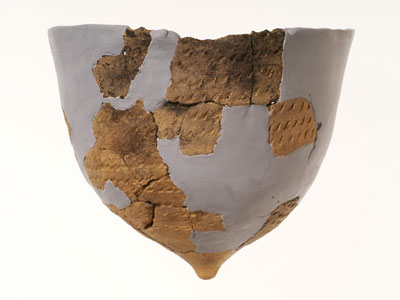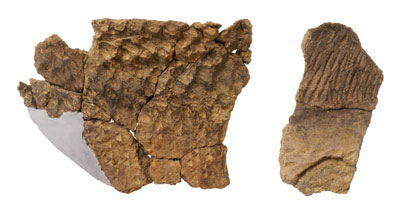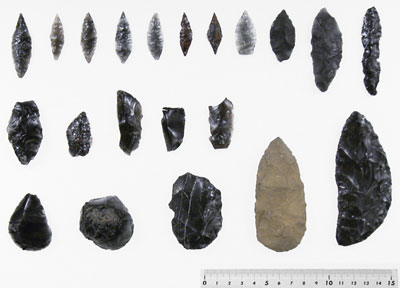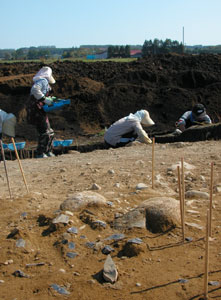Taishō No. 3:
The first Incipient Jōmon site is discovered in Hokkaido.

Reconstructed tsumegatamon pottery A vessel approximately 6 mm in thickness, with a nipple-like protrusion on its bottom. The design of puncture marks, made by the potter’s fingernail, is continuously applied horizontally across the entire surface, except for the bottom. |

Recovered shards of tsumegatamon pottery Visible among the fingernail impressions comprising the tsumegatamon design are items shaped like grains of rice, triangular and lunar crescent items, and items consisting of two oblique short lines in the shape of the Chinese character for “eight.” Other designs include comb-tooth designs and cord impressions in which two or three triangular shapes repeat as a unit. More frequent than the reconstructed example in the photograph above, which has tsumegatamon executed over its entire surface, are examples as shown here in which the upper and lower portions of the vessel bear different designs. While elements in common may be discerned, for individual examples, with ryūkisenmon (slender clay ridge decoration) and tsumegatamon styles known from Honshu, taken as a whole the Hokkaido pottery can be said to have a strongly independent flavor. |

Stone arrowpoints recovered with the pottery Obsidian is the main material, but small amounts of andesite were also used. Items clearly made from stone blades, such as tanged points and microliths, were not found. Item at far left is 5.5 cm in length. | |

Excavation in progress Pottery and stone tools were recovered in large numbers at about 40 cm below the modern surface. |

Panorama, Taishō No. 3 Site (from the south) Artifacts from the Incipient Jōmon were recovered from the northern side of the terrace, in the right side of the photo. |
Taishō No. 3 Site, Obihiro City, Hokkaido
Incipient Jōmon artifacts recovered in large numbers from the lowlands of eastern Hokkaido
Taishō No. 3 is located in the southern portion of the Tokachi plain, atop a terrace overlooking the Tobetsu river, a branch of the Tokachi river flowing across the plain, in the eastern part of Hokkaido.
Excavation was conducted in 2003, and artifacts and features of the Jōmon period were found, starting with artifacts from the Incipient Jōmon, and including pit dwellings of the microlithic culture of the Early Jōmon, plus graves from the final portion of the Early Jōmon. This is the first discovery of a site dating from the Incipient Jōmon in Hokkaido.
The more than 9,000 artifacts of the Incipient Jōmon were recovered from the stratum of loam deposited directly on top of a gravel layer in the terrace. In horizontal terms, they concentrated in a belt at the edge of the terrace, stretching twenty meters north-south by five meters east-west. Approximately 400 potsherds were recovered, an amount thought to represent more than ten individual vessels. Of these, it is possible to reconstruct the vessel shape for about five items. It appears that all had nipple-like projections at the bottom. The designs include cord impressions and puncture marks of various types including tsumegatamon, and some also have raised belts applied to the surface.
Stone tools number approximately 8,600 items, including flakes, with obsidian being the main material, and small amounts of andesite also used. The composition of stone tools includes points and spatulate tools, bifacially retouched tools, burins, end scrapers and side scrapers, awls, grooved flakes, and so forth, with small points and spatulate tools being characteristic.
AMS radiocarbon dating of carbonized matter adhering to the interior surfaces of the pots indicates an age of 12,500-12,000 bp. The current investigation has determined that sites of the Incipient Jōmon period exist without doubt in the interior of the eastern portion of Hokkaido, providing data noteworthy for making us rethink the issue of the beginning of the Jōmon period. (Kitazawa Minoru, Yamahara Toshirō)
